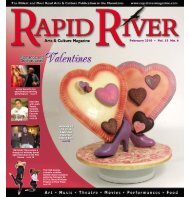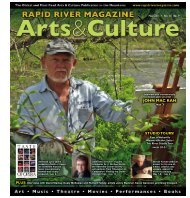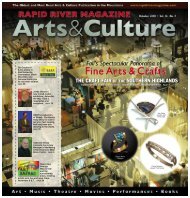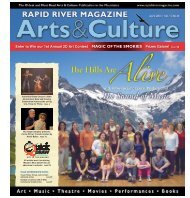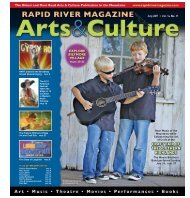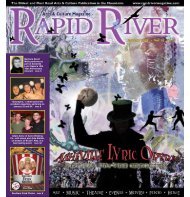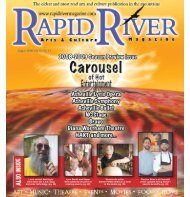JONAS GERARD - Rapid River Magazine
JONAS GERARD - Rapid River Magazine
JONAS GERARD - Rapid River Magazine
You also want an ePaper? Increase the reach of your titles
YUMPU automatically turns print PDFs into web optimized ePapers that Google loves.
R A P I D R I V E R A R T S & C U L T U R E M A G A Z I N E<br />
poetry & poets<br />
Lenard D. Moore: The Less-is-More Aesthetic<br />
BY TED OLSON<br />
A<br />
t some point in their student careers,<br />
most Americans are required<br />
to write a haiku. This diminutive<br />
Japanese poetic form is of course<br />
deeply misunderstood, as two popular<br />
notions cloud public perception. For<br />
one thing, people think that a haiku should<br />
be three lines and 17 syllables in length,<br />
with the first and third lines possessing five<br />
syllables each and the second line containing<br />
seven syllables. Another notion is that<br />
composing a haiku demands no particular<br />
skill or practice.<br />
Poetry Contest for Joyce<br />
Kilmer Memorial Forest<br />
75th Anniversary<br />
T<br />
his year marks the 75th Anniversary<br />
of the dedication of the<br />
Joyce Kilmer Memorial Forest,<br />
a living memorial to writer/poet<br />
Joyce Kilmer, best known for the<br />
poem, “Trees.”<br />
Kilmer was<br />
killed in action<br />
during World War<br />
I while serving in<br />
France on July 30,<br />
1918. The Stecoah<br />
Valley Cultural<br />
Arts Center is<br />
sponsoring a Poetry<br />
Contest to honor this anniversary.<br />
The 75th Anniversary Celebration will<br />
take place on July 30, 2011.<br />
The poetry contest is open to school<br />
children in grades K-12, and to adults<br />
and professional writers as well. The<br />
contest asks for poems to be submitted<br />
about a tree, trees, or forests, with entries<br />
divided by grade levels, (K-4, 5-8,<br />
High School), and adult/professional.<br />
All poems submitted will be received<br />
by Stecoah Valley cultural Arts Center<br />
and judged by a panel consisting of<br />
teachers, writers, and the general public.<br />
First, second, and third place winners,<br />
along with one honorable mention, will<br />
be chosen from each category.<br />
The winning poems will be displayed<br />
at the 75th Anniversary, and the authors<br />
will be recognized at the 75th Anniversary<br />
Celebration event on July 30, 2011.<br />
Once the judging has been completed<br />
and the winners notified, submissions<br />
will be publicly displayed at the Stecoah<br />
Valley Cultural Arts Center.<br />
Complete information about the poetry<br />
contest, along with entry forms, can be<br />
found at www.stecoahvalleycenter.com.<br />
Entry deadline: May 31, 2011<br />
Raleigh, North Carolina-based poet<br />
Lenard D. Moore knows better, as do those<br />
scholars who have investigated the history<br />
of Japanese literature. Indeed, relatively few<br />
poets throughout the ages have achieved<br />
sustained artistic success in the composition<br />
of haiku (perhaps the best-known person<br />
being the great seventeenth century Japanese<br />
poet Matsuo Basho).<br />
Moore is a modern-day haiku master.<br />
Consider this poem, which bends the conventional<br />
“rules” for haiku:<br />
Easter Sunday<br />
on the Obituary page<br />
no names I know<br />
Moore’s haiku,<br />
while comprised<br />
of three<br />
lines, consists<br />
of 16 syllables<br />
total, with the first and third lines each<br />
containing four syllables, and the second<br />
line eight syllables. This haiku’s theme is simultaneously<br />
serious and meditative, and its<br />
creator certainly subscribes to the aesthetic<br />
that less is more. In the words of literary<br />
critic Marcy Smith Rice, “Lenard D. Moore<br />
can do in about 17 syllables what other writers<br />
can only hope to do in 17 volumes.”<br />
Moore’s haiku mastery is the stuff of<br />
legend. In 1988, out of 40,000 entries in a<br />
haiku contest sponsored by Japan Air Lines,<br />
Moore’s entry was selected as a finalist; and<br />
in 1992 a major Japanese newspaper, the<br />
Mainichi Daily News, selected another of<br />
his haiku as the best among the many haiku<br />
published in that paper’s haiku column<br />
that year. In 1983, 1994, and 2003, he was<br />
awarded the Haiku Museum of Tokyo<br />
Award. By 2008, Moore’s skill at the<br />
haiku was so widely recognized that<br />
he was elected President of the Haiku<br />
Society of America, the first Southerner<br />
and the first African American to<br />
hold that position.<br />
A widely published author,<br />
Moore is a leading voice in North Carolina<br />
literature. Other than during his service in<br />
the U.S. Army and a brief stint in California,<br />
he has lived in North Carolina all<br />
his life, having been born and reared in<br />
Jacksonville, North Carolina and having<br />
lived for some years in the piedmont (he<br />
is Assistant Professor of English at Mount<br />
Olive College). Moore has authored several<br />
books, including The Open Eye<br />
(1985),<br />
Forever Home<br />
(1992), and Desert Storm: A<br />
Brief History<br />
(1993).<br />
His poems have been published in<br />
dozens of literary anthologies and in over<br />
350 periodicals, and he has also written<br />
fiction, plays, and literary criticism.<br />
Most recognized for his poetry,<br />
Moore has received several literary<br />
awards (including the Raleigh Medals<br />
of Arts for Lifetime Achievement,<br />
the Indies Arts Award, the Margaret<br />
Walker Creative Writing Award,<br />
three Cave Canem Fellowships, and<br />
a Sam Ragan Fine Arts Award); twice his<br />
poems have been nominated for the gious Pushcart Prize.<br />
presti-<br />
Moore has also held various editorial<br />
roles. In 2007-2008, he was the haiku editor<br />
of the on-line periodical Simply Haiku:<br />
A Quarterly Journal of Japanese Short<br />
Form Poetry. More recently, he served as<br />
guest-editor for two widely regarded literary<br />
journals: a special volume of Obsidian:<br />
Literature in the African Diaspora<br />
entitled<br />
“Aforebo: A Harvest of North Carolina<br />
Writers of African Descent,” and a thematically<br />
focused issue of Solo Café<br />
exploring<br />
the literary interactions between teachers<br />
and students. He is the Founder and Executive<br />
Director of the Raleigh-based Carolina<br />
African American Writers’ Collective, a<br />
workshop and readers’ group comprised of a<br />
range of people involved in the literary arts.<br />
Interestingly, and a testament to his<br />
range as a writer, Moore’s most recent poetry<br />
book, A Temple Looming<br />
(WordTech<br />
Editions, 2008) contains not a single haiku.<br />
All 41 poems in this book are cast into<br />
longer poetic forms, and yet all of the poems<br />
possess qualities associated with haiku: concision,<br />
directness, and verbal delicacy.<br />
The poems in A Temple Looming<br />
reflect<br />
the considerable influence of the haiku<br />
tradition in that they incorporate—and in<br />
some cases are constructed out of—striking<br />
images. Consider the poem “This Black<br />
Man,” which consists of five lines that build<br />
up to a memorable final image:<br />
The black felt hat trimmed with wide ribbon<br />
cools on his left leg.<br />
His tight tweed coat is fastened<br />
over yoke of his white shirt and thin tie.<br />
He waits, sheened as a leaf.<br />
Moore’s poem avoids judging “this<br />
black man” through some sort of subjective<br />
assessment. Instead, Moore employs an image<br />
to serve as a vehicle for a more objective<br />
representation of the man’s essential character.<br />
By viewing this man in a detached,<br />
unbiased light, the poem authenticates the<br />
man’s existence.<br />
Some of the book’s strongest poems<br />
conjure the real, regal spirits of various<br />
heroines. “The Speaking Face of Delilah,”<br />
for instance, conveys a young person’s dependence<br />
on his mother for physical safety<br />
and emotional security on a Southern farm.<br />
Struggle was my life, mixed blood.<br />
I stayed simple on southern soil.<br />
I bent low in countless cotton fields,<br />
Back ached like a tooth gone bad.<br />
“Let’s leave,” I whispered to my mother.<br />
She stopped and clutched my hand, speechless.<br />
Other poems in A<br />
Temple Looming<br />
are<br />
subtly descriptive, such<br />
as “Abandoned Farm,”<br />
in which Moore plied<br />
his evocative poetic style<br />
in order to give voice to a<br />
rural environment rendered<br />
speechless by human neglect:<br />
Doorless in daylight,<br />
it teeters on a frosty plot<br />
gone brown.<br />
No lid covers<br />
the deep hole<br />
in the earth.<br />
The people<br />
who built the outhouse<br />
cared<br />
how sloped,<br />
how far the outhouse was<br />
from the plankhouse,<br />
stamped<br />
this earth<br />
as shadows blackened the base<br />
of the outhouse<br />
twice the size of a phone booth.<br />
No voice rises in the air.<br />
A column of shut barns<br />
leans<br />
like boxes sealing old memories,<br />
closed coffins desiccate<br />
on shadow-struck acres,<br />
left to leafless trees.<br />
Whether he composes shorter poems<br />
(his acclaimed work in the haiku, for<br />
example, or his lesser known efforts in the<br />
Japanese form known as the tanka) or he<br />
opts to write longer poems (such as the<br />
graceful work included in A Temple Loom-<br />
ing), Lenard D. Moore not only understands<br />
that “less is more” but also possesses the<br />
rare qualities of vision and restraint, both of<br />
which are necessary to render that aesthetic<br />
vital and meaningful.<br />
Ted Olson is the author of<br />
such books as Breathing<br />
in Darkness: Poems<br />
(Wind<br />
Publications, 2006) and Blue<br />
Ridge Folklife<br />
(University Press<br />
of Mississippi, 1998) and<br />
he is the editor of numerous<br />
books, including CrossRoads:<br />
A Southern Culture Annual<br />
(Mercer University<br />
Press, 2009). His experiences as a poet and<br />
musician are discussed on www.windpub.<br />
com/books/breathingindarkness.htm.<br />
Poets who would like for their poetry to be<br />
considered for a future column may send their<br />
books and manuscripts to Ted Olson, ETSU, Box<br />
70400, Johnson City, TN 37614. Please include<br />
contact information and a SASE with submissions.<br />
26 April 2011 — RAPID RIVER ARTS & CULTURE MAGAZINE — Vol. 14, No. 8




